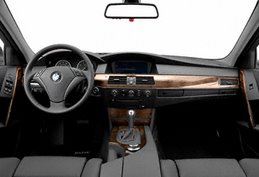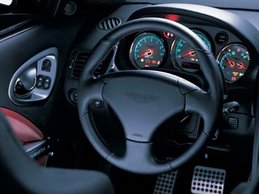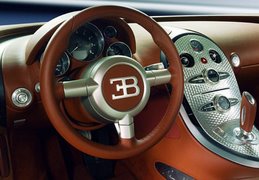 Bugatti Veyron 16.4 - It is a production car developed and tested to the standards of Volkswagen, Bugatti's parent company. With a top speed of 253 mph, it is also the fastest production car ever built.
Bugatti Veyron 16.4 - It is a production car developed and tested to the standards of Volkswagen, Bugatti's parent company. With a top speed of 253 mph, it is also the fastest production car ever built.Production, of course, is a relative term. In the case of the Veyron, Bugatti plans to build only about 50 cars a year at a price of €1 million, which is about $1,250,000 as this is written. To this rarefied market Bugatti has brought an unusual level of sophistication and engineering necessitated by the promise of 1001 metric horsepower (or 987 American horses) and a top speed of 252 mph, a pledge from former VW boss Ferdinand Piëch when he unveiled the production-intent Veyron at the 2001 Geneva auto show.
When I ask Bugatti development boss Wolfgang Schreiber to explain how the same engine can be rated at 1001 SAE net horsepower at 6000 rpm for the U.S. but only 987 horsepower (1001 PS) for Europe, he laughs, saying, "The production engines are all putting out between 1020 and 1040 PS—enough to cover both promises."
All that twist required a dedicated transmission. The Veyron gets a King Kong seven-speed versi
 on of VW's twin-clutch gearbox, called DSG. Like the DSG available in the Audi TT, it operates with an automatic mode or a full manual mode via paddle shifters. Because gearchanges occur with one clutch disengaging as the other engages, shifts are uniformly smooth and swift.
on of VW's twin-clutch gearbox, called DSG. Like the DSG available in the Audi TT, it operates with an automatic mode or a full manual mode via paddle shifters. Because gearchanges occur with one clutch disengaging as the other engages, shifts are uniformly smooth and swift.An engine—particularly a turbocharged one—that develops four-digit power throws off more heat than a dozen pizza ovens. Consequently, in the nose of the Veyron are three coolant radiators, one heat exchanger for the twin air-to-liquid intercoolers, and two air-conditioning condensers. There are also transmission and differential oil coolers on the right side and a large engine-oil cooler in the left-side air intake.
We started with two familiarization laps to get a feel for the track and the car. The track is simple, with a pair of high-banked, 150-mph corners connected by two five-mile-long straights—one of which has a slight bend so that it touches a common parking area.
Even after it was lowered to my preferred position, the steering wheel did not obstruct my view of the instrument cluster. And despite the Veyron's low, 47.5-inch height, there was plenty of clearance between my helmeted head and the headliner. Schreiber promises the car will accommodate drivers as tall as six foot seven.
What's more, the acceleration doesn't slacken when you hit triple-digit speeds. In my first lap, I took the car up to about 185 mph, at which point the tire noise was fairly loud but the Veyron was otherwise calm and relaxed.
But 230 mph is about as fast as the Veyron will go until you put th
 e car into top-speed mode. This involves coming to a stop and, while the car is idling, turning a key in a lock on the floor to the left of the driver's seat. When you do that, the car sinks down even lower on its suspension, until ground clearance has been reduced to a mere 2.6 inches in front and 2.8 in the rear.
e car into top-speed mode. This involves coming to a stop and, while the car is idling, turning a key in a lock on the floor to the left of the driver's seat. When you do that, the car sinks down even lower on its suspension, until ground clearance has been reduced to a mere 2.6 inches in front and 2.8 in the rear.Developing tires that could withstand 250-plus mph while supporting up to 4800 pounds of car, occupants, and downforce was one of the major technical challenges of the Veyron, and judging by the comparative lack of concern about the tires during my run, I'd say this problem has been solved.













No comments:
Post a Comment